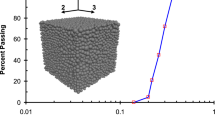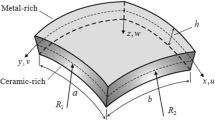Abstract
Length scale dependent deformation in polymers has been reported in the literature in different experiments at the micron and submicron length scales. Such length scale dependent deformation behavior can be described using higher order gradient theories. A numerical approach for axisymmetric problems is presented here where a couple stress elasticity theory is employed. For the numerical formulation, a penalty finite element approach is proposed and implemented with C 0 axisymmetric elements. In this approach, rotations are introduced as nodal variables independent of nodal displacements, and the penalty term is used to minimize the difference in rotations determined from nodal displacements and nodal rotations. Numerical simulations are performed on different examples to assess the performance of the suggested approach. In particular, a circular cylinder with spherical inclusions and the interaction of the inclusion with the boundary are studied. It is found that with the length scale parameter the distance with which the free boundary affects the stress state of the inclusion increases as well.
Similar content being viewed by others
References
Cheng Y.T., Cheng C.M.: Scaling, dimensional analysis, and indentation measurements. Mater. Sci. Eng. R 44, 91–149 (2004)
Fleck N.A., Muller G.M., Ashby M.F., Hutchinson J.W.: Strain gradient plasticity: theory and experiments. Acta Metall. Mater. 42, 457–487 (1994)
Stolken J.S., Evans A.G.: A microbend test method for measuring the plasticity length scale. Acta Mater. 46, 5109–5115 (1998)
Nakamura Y., Yamaguchi M., Okubo M., Matsumoto T.: Effects of particle size on mechanical and impact properties of epoxy resin filled with spherical silica. J. Appl. Polym. Sci. 45, 1281–1289 (1992)
Tjernlund J.A., Gamstedt E.K., Gudmundson P.: Length-scale effects on damage development in tensile loading of glass-sphere filled epoxy. Int. J. Solids Struct. 43, 7337–7357 (2006)
Han C.-S., Nikolov S.: Indentation size effects of polymers and related rotation gradients. J. Mater. Res. 22, 1662–1672 (2007)
Han C.-S.: Influence of the molecular structure on indentation size effect in polymers. Mater. Sci. Eng. A 527, 619–624 (2010)
Alisafaei F., Han C.-S., Sanei S.H.R.: On the time and indentation depth dependence of hardness, dissipation and stiffness in polydimethylsiloxane. Polym. Test. 32, 1220–1228 (2013)
Tatiraju R.V.S., Han C.-S.: Rate dependence of indentation size effects in silicone filled rubber. J. Mech. Mater. Struct. 5, 277–288 (2010)
Lam D.C.C., Yang F., Chong A.C.M., Wang J., Tong P.: Experiments and theory in strain gradient elasticity. J. Mech. Phys. Solids 51, 1477–1508 (2003)
Shu J.Y., King W.E., Fleck N.A.: Finite elements for materials with strain gradient effects. Int. J. Numer. Methods Eng. 44, 373–391 (1999)
Han C.-S., Ma A., Roters F., Raabe D.: A Finite Element approach with patch projection for strain gradient plasticity formulations. Int. J. Plast. 23, 690–710 (2007)
Lee M.G., Han C.-S.: An explicit finite element approach with patch projection technique for strain gradient plasticity formulations. Comput. Mech. 49, 171–183 (2012)
Eringen A.C., Suhubi E.S.: Nonlinear theory of simple micro-elastic solids—I. Int. J. Eng. Sci. 2, 189+ (1964)
Mindlin R.D., Tiersten H.F.: Effects of couple-stresses in linear elasticity. Arch. Ration. Mech. Anal. 11, 415–448 (1962)
Toupin R.A.: Elastic materials with couple-stresses. Arch. Ration. Mech. Anal. 11, 385+ (1962)
Koiter W.T.: Couple stresses in the theory of elasticity I and II. Proc. K Ned. Akad. Wet. B 67, 17–44 (1964)
Yang F., Chong A.C.M., Lam D.C.C., Tong P.: Couple stress based strain gradient theory for elasticity. Int. J. Solids Struct. 39, 2731–2743 (2002)
Asghari M., Kahrobaiyan M.H., Rahaeifard M.: Investigation of the size effects in Timoshenko beams based on the couple stress theory. Arch. Appl. Mech. 81, 863–874 (2011)
Akgoz B., Civalek O.: Analysis of micro-sized beams for various boundary conditions based on the strain gradient elasticity theory. Arch. Appl. Mech. 82, 423–443 (2012)
Zhou, S.-S., Gao, X.-L.: A nonclassical model for circular Mindlin plates based on a modified couple stress theory. ASME J. Appl. Mech. 81(5), 051014–051014-8 (2014). doi:10.1115/1.4026274
Wang Y.-G., Lin W.-H., Zhou C.-L.: Nonlinear bending of the size-dependent circular microplates based on the modified coupe stress theory. Arch. Appl. Mech. 84, 391–400 (2014)
Mousavi, S.M., Paavola, J.: Analysis of plate in second strain gradient elasticity. Arch. Appl. Mech. (2014). doi:10.1007/s00419-014-0871-9
Akgoz B., Civalek O.: Free vibration analysis for single-layered graphene sheets in an elastic matrix via modified couple stress theory. Mater. Des. 42, 164–171 (2012)
Wang J., Lam D.C.C.: Nanostiffening in polymeric nanocomposites. Comput. Mater. Contin. 17, 215–232 (2010)
Anderson W.B., Lakes R.S.: Size effects due to Cosserat elasticity and surface damage in closed-cell polymethacrylimide foam. J. Mater. Sci. 29, 6413–6419 (1994)
Askes H., Bennett T., Aifantis E.C.: A new formulation and C0-implementationof dynamically consistent gradient elasticity. Int. J. Numer. Methods Eng. 72, 111–126 (2007)
Petera J., Pittman J.F.T.: Isoparametric Hermite elements. Int. J. Numer. Methods Eng. 37, 3489–3519 (1994)
Akarapu S., Zbib H.M.: Numerical analysis of plane cracks in strain-gradient elastic materials. Int. J. Fract. 141, 403–430 (2006)
Fischer P., Klassen M., Mergheim J., Steinmann P., Müller R.: Isogeometric analysis of 2D gradient elasticity. Comput. Mech. 47, 325–334 (2011)
Amanatidou E., Aravas N.: Mixed finite element formulations of strain-gradient elasticity problems. Comput. Methods Appl. Mech. Eng. 191, 1723–1751 (2002)
Askes H., Gutierrez M.A.: Implicit gradient elasticity. Int. J. Numer. Methods Eng. 67, 400–416 (2006)
Zervos A.: Finite element for elasticity with microstructure and gradient elasticity. Int. J. Numer. Methods Eng. 73, 564–595 (2008)
Engel G., Garikipati K., Hughes T.J.R., Larson M.G., Mazzei L., Taylor R.L.: Continuous/discontinuous finite element approximations of fourth order elliptic problems in structural and continuum mechanics with applications to thin beams and plates, and strain gradient elasticity. Comput. Methods Appl. Mech. Eng. 191, 3669–3750 (2002)
Wood R.D.: Finite element analysis of plane couple-stress problems using first order stress functions. Int. J. Numer. Methods Eng. 26(2), 489–509 (1988)
Garg N., Han C.-S.: A penalty finite element approach for couple stress elasticity. Comput. Mech. 52, 709–720 (2013)
Zhao J., Chen W., Ji B.: A weak continuity condition of FEM for axisymmetric couple stress theory and an 18-DOF triangular axisymmetric element. Finite Elem. Anal. Des. 46, 632–644 (2010)
Nikolov, S., Han, C.-S., Raabe, D.: On the origin of size effects in small-strain elasticity of solid polymers. Int. J. Solids Struct. 44, 1582–1592. Corrigendum in Int. J. Solids Struct. 44, 7713–7713 (2007)
Kennedy T.C., Kim J.B.: Dynamic stress-concentrations in micropolar elastic-materials. Comput. Struct. 45, 53–60 (1992)
Pothier A., Rencis J.J.: 3-Dimensional finite-element formulation for microelastic solids. Comput. Struct. 51, 1–21 (1994)
Providas E., Kattis M.A.: Finite element method in plane Cosserat elasticity. Comput. Struct. 80, 2059–2069 (2002)
Li L., Xie S.: Finite element method for linear micropolar elasticity and numerical study of some scale effects phenomena in MEMS. Int. J. Mech. Sci. 46, 1571–1587 (2004)
Huang F.Y., Yan B.H., Yan J.L., Yang D.U.: Bending analysis of micropolar elastic beam using a 3-D finite element method. Int. J. Eng. Sci. 38, 275–286 (2000)
Gomez J., Basaran C.: Computational implementation of Cosserat continuum. Int. J. Mater. Prod. Tech. 34, 3–36 (2009)
Lawson, C.L., Hanson, R.J.: Bounds for the condition number of a triangular matrix. In: Solving Least Square Problems, Society for Industrial and Applied Mathematics, Philadelphia, pp 28–35 (1995)
Lemeire F.: Bounds for condition numbers of triangular and trapezoid matrices. BIT 15, 58–64 (1975)
O’Connell P.A., McKenna G.B.: The stiffening of ultrathin polymer films in the rubbery regime: the relative contributions of membrane stress and surface tension. J. Polym. Sci. Part B Polym. Phys. 47, 2441–2448 (2009)
Author information
Authors and Affiliations
Corresponding author
Rights and permissions
About this article
Cite this article
Garg, N., Han, CS. Axisymmetric couple stress elasticity and its finite element formulation with penalty terms. Arch Appl Mech 85, 587–600 (2015). https://doi.org/10.1007/s00419-014-0932-0
Received:
Accepted:
Published:
Issue Date:
DOI: https://doi.org/10.1007/s00419-014-0932-0




